|
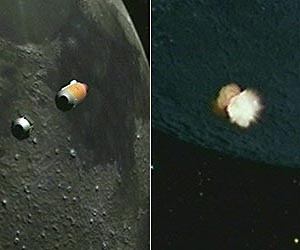 LRO Detects Surprising Gases In LCROSS Lunar Impact Plume
LRO Detects Surprising Gases In LCROSS Lunar Impact PlumeBoulder CO (SPX) Oct 22, 2010 NASA's Lunar Reconnaissance Orbiter (LRO) and its sophisticated suite of instruments have determined that hydrogen, mercury and other volatile substances are present in permanently shaded soils on the Moon, according to a paper published in Science. The Lunar Crater Remote Observation and Sensing Satellite (LCROSS), which launched with LRO, was intentionally crashed onto the Moon's surface Oct. 9, 2009, while LRO instruments watched. About 90 seconds after LCROSS hit the Moon, LRO flew past the de ... read more |
. |
|
|
Free Space, Earth, Energy And Military Newsletters - Delivered Daily |
| . | . |
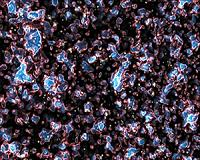 Beyond The Fog Of Time Most Distant Galaxy Ever Unvieled A European team of astronomers led by Paris Observatory CNRS Director of Research Matthew Lehnert using ESO's Very Large Telescope (VLT) has measured the distance to the most remote galaxy so far. B ... more | .. |
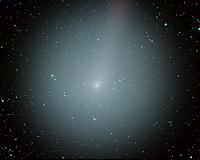 Comet Hartley 2 Visible In Morning Sky This Week The small comet Hartley 2 makes its closest approach to Earth today and should be visible to the unaided eye for several days under dark skies in the hours before dawn, according to the editors of S ... more | .. |
 Dark Energy Project Receives NSF Grant A project to discover the nature of dark energy, a mysterious force causing the expansion of the universe to speed up, has received an $8 million grant from the National Science Foundation (NSF). ... more | .. |
 India to build neutrino observatory India says it will build a more than quarter-billion-dollar underground facility to join the worldwide search for elusive neutrino particles. The country's Environment and Forests Ministry has gi ... more | .. |
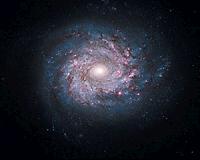 Pinwheel Of Star Birth Though the universe is chock full of spiral-shaped galaxies, no two look exactly the same. This face-on spiral galaxy, called NGC 3982, is striking for its rich tapestry of star birth, along with it ... more |
|
Free Space, Earth, Energy And Military Newsletters - Delivered Daily |
| .. |
When Is A Comet Not A Comet Paris, France (ESA) Oct 21, 2010
Paris, France (ESA) Oct 21, 2010It was a case of celestial hit and run. Two asteroids, both in the wrong place at the wrong time. The result: one big trail of debris and a case of mistaken identity. Now, however, ESA's comet-chaser Rosetta has unravelled the truth. Using its OSIRIS camera, Rosetta made the breakthrough because it is far from Earth and so it could look at mystery object 'P/2010 A2' from a unique perspecti ... more New Beam Source For Brookhaven Accelerators  Upton NY (SPX) Oct 21, 2010
Upton NY (SPX) Oct 21, 2010A new source of ions will soon be the starting point for the beams entering two major research facilities at the U.S. Department of Energy's (DOE) Brookhaven National Laboratory - the Relativistic Heavy Ion Collider, where physicists are recreating conditions of the early universe to learn more about the forces that hold matter together, and the NASA Space Radiation Laboratory, where scientists ... more Astronomer Employs HPC To Peer Into Cosmic Mysteries  Columbus OH (SPX) Oct 20, 2010
Columbus OH (SPX) Oct 20, 2010An Ohio State University astronomer is working to unlock some of the mysteries surrounding the formation of vast galaxies and the evolution of massive black holes with his own large constellation of silicon wafers. Over the last year, two research teams led by Stelios Kazantzidis, a Long-Term Fellow at the Center for Cosmology and Astro-Particle Physics (CCAPP) at The Ohio State University ... more |
.. |
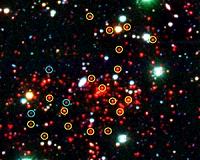 Massive Early Galaxy Cluster Observed 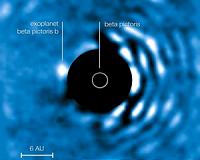 Planet Hunters No Longer Blinded By The Light  Instant online solar energy quotes Solar Energy Solutions from ABC Solar |
.. |
|
|
Free Space, Earth, Energy And Military Newsletters - Delivered Daily |
|
|
. |
 Astronomers Find Weird, Warm Spot On An Exoplanet
Astronomers Find Weird, Warm Spot On An ExoplanetPasadena CA (JPL) Oct 20, 2010 Observations from NASA's Spitzer Space Telescope reveal a distant planet with a warm spot in the wrong place. The gas-giant planet, named upsilon Andromedae b, orbits tightly around its star, with one face perpetually boiling under the star's heat. It belongs to a class of planets termed hot Jupiters, so called for their scorching temperatures and large, gaseous constitutions. One might think the hottest part of these planets would be directly under the sun-facing side, but previous observations h ... read more |
| The contents herein, unless otherwise known to be public domain, are Copyright 1995-2010 - SpaceDaily. AFP and UPI Wire Stories are copyright Agence France-Presse and United Press International. ESA Portal Reports are copyright European Space Agency. All NASA sourced material is public domain. Additional copyrights may apply in whole or part to other bona fide parties. Advertising does not imply endorsement, agreement or approval of any opinions, statements or information provided by SpaceDaily on any web page published or hosted by SpaceDaily. Privacy statement |
|
Free Space, Earth, Energy And Military Newsletters - Delivered Daily |
| Previous Issues | Oct 21 | Oct 20 | Oct 19 | Oct 18 | Oct 15 |